
 |
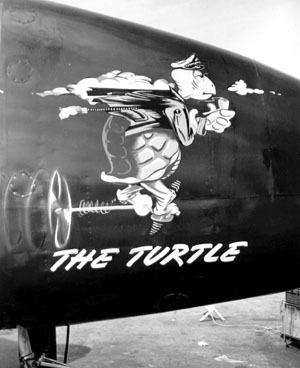
 |
|
Lockheed P2V-1 Neptune 89082
The Turtle (MSN 26-1003) of the U.S. Navy at Guildford, Perth on
18 September 1946, probably not long after its surprise arrival. Baggage
belonging to the seven crew has been unloaded from the bomb bay. Most
of this baggage would have made the return journey on the R5D Skymaster
as the Commander of the Neptune later stated that his baggage on the record
flight consisted of a paper bag containing a change of uniform!
|
|
In September 1946, the Lockheed
Neptune was state of the art with some of its equipment still on the secret
list. So why did the third Neptune off the production line, which had
flown for the first time just three weeks previously, suddenly descend,
virtually unannounced on postwar Perth, Western Australia?
With the destination being
determined by the requirement for a grandstand finish, it only remained
to determine the point of origin by working backwards to find a suitably
distant, friendly airfield and that emerged as Perth, Western Australia.
THE TURTLE'S FUEL TANKS
NOTES ON FUEL
CONVERSIONS
JATOCrucial to the operation was
JATO - Jet Assisted Take Off. By definition, the two bottles attached
to each side of the Turtle's rear fuselage were actually rockets
but developers of the system thought that the word "rocket"
might be a bit too "science fiction" for public consumption
so the JATO acronym stuck. WEIGHT ANALYSIS
EMERGENCY EQUIPMENT
|
|||||||||||||||||||||||||||||||||||||||||||||||||||||||||||||||||||||||||||||||||||||||||||||||||||||||||||||||||||||||||||||||||||||||||||||||||||||||||||||||||||||||||||||||||||||||||||||||||||||||||||||||||||||||
|
GUILDFORD
|
|
| 06/24 | 6,000 feet sealed |
| 11/29 | 6,000 feet sealed |
|
PEARCE
|
|
| 05/23 | 6,045 feet sealed |
| 09/27 | 6,012 feet sealed |
| 14/32 | 4,000 feet sealed |
|
29AUG46
|
P2V-1 Bu No 89082 (MSN 26-1003) later known as The Turtle flew for the first time from Lockheed's Burbank plant. (Source: 3) | |
|
05SEP46
|
The
first physical sign that Perth was about to be thrust on to the world's
stage was the arrival in the port of Fremantle of the USS Rehoboth
(AVP-50), a U.S. Navy seaplane tender which was to be the support
ship for Operation Turtle. The ship docked at North Wharf berth
number 8 at 0800 hours on 5 September 1946. Commanded by Captain Keith
Maynard Krieger, himself a naval aviator, the Rehoboth was
equipped with engineering workshops and also carried support personnel,
including specialist aviation meteorologists. The ship also carried
a spare engine and propeller for the Neptune as well as other spares.
(Source: 2) Commissioned in February 1944, Rehoboth was named after Rehoboth Beach, Delaware. The vessel displaced 1,766 tons and had a length of 310 feet. (Source: 6) The name Rehoboth derives from Genesis 26:22. Coincidentally, Perth is home to the Rehoboth Christian College which was founded in 1966. |
|
|
SEP46
|
The
Turtle was test flown at high gross weights with three flights
using JATO. After extensive trials to develop performance charts,
The Turtle departed Burbank for Barber's Point, Hawaii and
Majuro in the Marshall Islands where it was tested on the crushed
coral airstrip. (Source: 7) The exact date of departure from Burbank is not recorded in the local press and evidently the news was suppressed because the planned record flight was not publicly announced in the USA until 18SEP46 by which time the Neptune had arrived in Perth to much local consternation. In later announcing the arrival of the Neptune in Perth, the West Australian of 19SEP46 stated that the aircraft had "left America four days ago." |
|
|
17SEP46
|
P2V-1 Neptune 89082 arrived at RAAF Garbutt (Townsville), QLD. (Source: 20) It would seem that the aircraft escaped the attention of the local press. | |
| It is appropriate that the first Neptune to land in Australia should do so at Townsville, which was later to become the base for P2V-7 Neptunes operated by No 10 Squadron RAAF. It is also appropriate that the record flight itself should depart from Pearce which was later the base for P2V-5 Neptunes operated by No 11 Squadron RAAF. | ||
|
18SEP46
|
P2V-1 Neptune 89082 departed RAAF Garbutt for Guildford (Perth) WA. (Source: 8) | |
|
18SEP46
|
The Turtle landed at Perth's Guildford Airport. It was reported
that some of the seven crew were civilian employees of Lockheed. A
rope barrier and an armed guard protected the aircraft and the entry
hatch was locked. Captain of the aircraft was Commander T.D. Davies
who is also project officer for the aircraft on the staff of the United
States Navy Bureau of Aeronautics. He was quoted in the local press
saying; "She's been my baby for the last two years, almost from
the start, so you can imagine that I'm very happy that she has performed
so well. The only complaints I have with the trip is that I got pretty
sore sitting in the pilot's seat over the 9,400 mile journey and some
leaks in the roof of the pilot's cabin let a little rain in. It has
certainly been a most satisfactory trip. There is no doubt that the
aircraft is a success." (Source: 8) The flight crew of the Neptune were: Commander Tom D. Davies of Cleveland, Ohio Commander Eugene P. 'Gene' Rankin of Sapulpa, Oklahoma Commander Walter Shipstead Reid of Washington, D.C. Lieutenant Commander Roy H. Tabeling of Jacksonville, Florida. Commander Reid was the only member of the crew familiar with Perth as he had served on Catalinas at Crawley Bay during the war. Additional civilian crew on the ferry flight to Perth were: Frank Osberg (Lockheed Flight Test Engineer) Stuart Sanford (Lockheed Flight Test Inspector) Ralph Plue (Lockheed Radio Mechanic) (Source: 2) |
|
|
18SEP46
|
U.S. Navy Douglas R5D Skymaster Bu No 50853 (MSN 10430) landed at Adelaide's Parafield Airport having arrived from Brisbane en route to Perth. The aircraft was under the command of Lt Commander K.K. Kelley who told the local press that; "We touched down fairly well into the field and had to brake hard to pull up in the room we had. Ordinarily we don't have to use the brakes at all on a landing. That field will be harder to get out of than it was to get into and it wouldn't want to be any softer than it was today." The aircraft was the first DC-4 Skymaster to land at Parafield. Lt Cdr Kelley advised the press that the decision to land at Parafield was based on an assumption that ANA's DC-4s used the field on scheduled services from Melbourne to Perth. (They did not!) (Source: 6) | |
|
18SEP46
|
AAP
reported from Washington that the Navy Department had announced plans
for a 9,000 mile flight from Perth to Seattle which was expected to
take 44 hours. "Vice-Admiral Radford, Deputy Chief of Naval Operations
for Air, said that complete latitude would be given to the pilot to
continue after reaching the west coast if he thought it best."
(Source: 7) In reporting this announcement, the West Australian of 20SEP46 commented; "News of the special return journey has somewhat lifted the air of secrecy surrounding the reason why the Neptune, one of the first planes of its make to be built, suddenly arrived in this State on Wednesday." (Source: 9) |
|
|
19SEP46
|
The Skymaster departed Parafield at approximately 0825 hours with no apparent difficulty. (Source: 7) | |
|
19SEP46
|
The
Skymaster arrived at Guildford, Perth in the afternoon after a 7 hour
5 minute flight from Parafield. The aircraft carried thirteen technicians
who commenced work on the Neptune within three hours of their arrival.
The aircraft was described as The Flying Workshop but it is
unlikely that this name was actually painted on the aeroplane. Further
describing the Neptune, the West Australian reported that;
"it was impossible to see inside the Neptune as the normally
transparent nose had been whitened over." (Source: 9) Commander Davies denied press speculation that the white paint was to hide secret equipment, explaining that it was "to screen the radio compass." It is speculated that he may have been misquoted and the white area was a dielectric panel for the opposite purpose of transmitting radio waves. It was also revealed that the Neptune's tyre pressures had been increased to withstand the higher operating weights. These tyres were said to incorporate rubber "flaps" which caused the wheels to spin up before the aircraft landed. (Source: 2) |
|
|
20SEP46
|
The
West Australian of 21SEP46 announced that the Managing-secretary
of the South Perth Zoo, Mr W.C. Hobson, had donated a small female
wallaby joey as a goodwill gift from Western Australia to America.
The animal, which came to be known as Joey, would travel on
the Neptune in a crate with its own food supply. Also a collection
of West Australian wildflowers was presented to the crew as a gift.
(Source: 10) The reaction of Quarantine officials is not recorded and neither is the initial reaction of the crew to this unexpected payload. Nevertheless the Navy soon came to embrace the publicity value of the gesture. |
|
|
21SEP46
|
RAF
Lancaster PD328 Aries of the Empire Navigation School arrived
at Guildford, Perth from Laverton at 1515 hours. It was reported that
the aircraft would remain in Perth until early Monday morning (23SEP46).
(Source: 10) The presence of the Lancaster in Perth would have been purely coincidental as its schedule would have been in place long before the Neptune's record attempt had been announced. |
|
|
21-22SEP46
|
The West Australian of 23SEP46 reported that 20,000 people had visited Guildford on each day of the weekend to inspect the Neptune. In addition to the Neptune and the Skymaster, visitors were also able to view the RAF Lancaster PD328 Aries which itself had made several long-distance record flights. A departure time for the Neptune had not been determined because of cyclonic weather at Guam but it was expected to depart on Wednesday or Thursday (25/26SEP). Departure would be late in the afternoon to take advantage of cooler conditions and so that the aircraft would arrive over New Guinea in the early morning. It was also reported that the Neptune would be "ready for a test flight tomorrow morning" (24SEP). (Source: 11) | |
|
22SEP46
|
The R5D Skymaster Bu No 50853 performed at least one test flight during its stay in Perth. It is believed that the aircraft was flown on this date. | |
|
23SEP46
|
RAF
Lancaster PD328 Aries departed Guildford for Melbourne at 0700
hours. (Source: 12) The Lancaster departed Melbourne on 24SEP46 arriving back at Shawbury, UK on 02OCT46, having covered 32,094 miles in 165 hours, 34 minutes. (Source: 17) |
|
|
24SEP46
|
The
Neptune took-off from Guildford and landed at nearby RAAF Base Pearce
at approximately 1445 hours to collect Group Captain Colin Hannah
(AOC Western Area) and departed for Cunderdin and Guildford at 1530
hours. (Source: 20) The Neptune departed Guildford at 1707 hours on a test flight using JATO. It was reported that this was the aircraft's fourth flight using JATO since it was built. On board the aircraft for the JATO test, in addition to the normal four crew, were Group Captain Hannah, Mr R.W. Hefti, American Vice-Consul for WA and Captain K.M. Krieger of the USS Rehoboth. (Source: 13) Later, Air Marshal Sir Colin Hannah KCMG KCVO KBE CB was Governor of Queensland 1972-77. (Source: 19) |
|
|
25SEP46
|
The
West Australian of 26SEP46 announced that the record attempt
would now depart from RAAF Pearce to avoid any built-up areas around
Perth. Pearce is 26 miles north of the city and has two runways each
2,000 yards (6,000 feet) in length (the same as Guildford) and another
of 1,500 yards (4,500 feet). It was also reported that departure would
be delayed for "a day or two" because of unfavourable weather
north of Midway. (Source: 24) The need to shift the departure point to Pearce arose during an earlier test flight from Guildford on 24SEP46 using JATO when it emerged that launching the overloaded aircraft towards the Perth central business district was probably not such a good idea! It is likely that Group Captain Hannah was instrumental in having the departure point moved to Pearce. |
|
|
26SEP46
|
The
Neptune arrived at RAAF Pearce. (Source: 21) Before leaving Guildford, the Neptune was fitted with a crate to house its wallaby passenger which was now announced to be destined for the Washington Zoo. (Source: 14) The weight of the wallaby and its crate was later reported to be 35 pounds. (Source: 15) |
|
|
27SEP46
|
The R5D Skymaster Bu No 50853 arrived at RAAF Pearce. (Source: 21) | |
|
27SEP46
|
The West Australian of 27SEP46 reported that the Neptune was expected to depart at sunset on this date on its record attempt. (Source: 14) | |
|
27SEP46
|
The
Daily News, Perth of 27SEP46 announced that the departure of
the Neptune had been postponed "a day or two" because of
en route weather. It was reported that the aircraft would be carrying
the largest weather map ever prepared, given the hemispherical nature
of the flight. Commander Davies stated that the normal maximum take-off
weight for the aircraft was 58,000 pounds but for the record attempt
the Neptune would take-off at 84,000 pounds. After take-off the aircraft
would continue out to sea to drop the expended JATO bottles and then
turn back over Perth and track towards the Alice Springs and Cooktown
beacons. During their stay in Perth the crews of both aircraft had
befriended eleven year-old newspaper boy Martin Laughton who had inspected
the Neptune and been on a test flight of the Skymaster (believed to
be on 22SEP46). It was reported that young Martin had collected the
signatures of the crew in his autograph book. In addition to the crew
of the Neptune, his book was signed by; Lieutenant-Commander K.J. Perry Lieutenant-Commander Kenneth K. Kelley Lieutenant S.R. Sanford Lieutenant James M. Reedy Mr R.A. Bailey. (Source: 16) Robert A. Bailey was the Project Engineer for the Neptune. He joined Lockheed in 1937 and was not yet thirty years-old when he designed the Neptune. (Source: 2) |
|
|
29SEP46
|
The Neptune departed Pearce at 1811 hours (Source: 15 says 1810) on its record attempt. The take-off was recorded by the Australian Broadcasting Commission and British Empire Films. Present were the Lord Mayor of Perth and the U.S.A. Consul. The Lord Mayor, AOCWA Group Captain Hannah and Commander Davies were interviewed. The Skymaster departed for Guildford at 1857 hours. (Source: 21) | |
|
29SEP46
|
The
West Australian reported that the Neptune departed Pearce at
1810 hours (Source: 21 says 1811). Commander Davies would not commit
to a specific destination but the nominal destination was said to
be Seattle. "Even if the Neptune does not fly beyond Seattle,
it will have covered 9,312 miles and so improved on the present non-stop,
long-distance record by about 1,500 miles. But if, say, the plane
continued to the Atlantic coast via Chicago, it would have travelled
the equivalent of nearly half-way round the world — a distance
of more than 12,000 miles — non-stop in about two and a half
days. The continuance of the Great Circle route to the East Coast
of America would mean that the Neptune would land near Washington
D.C., where the kangaroo is destined." The aircraft carried a barograph to record its altitude and so verify that it had not landed anywhere en route. Just prior to take-off, the instrument was sealed by Mr J. Totterdell, the Lord Mayor of Perth. Officials from the Royal Aero Club acted as official time-keepers. After take-off, the aircraft was reported to be in constant radio contact with Guildford Airport and the USS Rehoboth. "Soon after midnight it was reported as having passed Alice Springs, about 1,230 miles from Perth. This indicates an air-speed of about 210 m.p.h. Messages received by the Aeradio Station at Guildford said that it passed 60 miles to the north of Kalgoorlie 90 minutes after leaving Perth, and Alice Springs at 12.05 a.m. today flying at 6,000 feet. Later reports received early in the morning as the aircraft continued on to Cooktown (Queensland) indicated that everything was progressing satisfactorily. A message at 1 a.m. said: Everything going fine. Kangaroo riding comfortably." (Source: 15) |
|
|
29SEP46
|
The Neptune carried philatelic items from Perth to Columbus, Ohio. The items were autographed by Cdr T.D. Davies and Cdr E.P. Rankin. (Source: Eustis, The Australian Air Mail Catalogue, 1990. Cat No 1067b). Possibly in addition, 200 covers were prepared on the USS Rehoboth and flown on the Turtle. (See example below). The fact that this cover is not signed by the crew suggests that Eustis may be describing a different flown cover. | |
|
29SEP46
|
"The
Turtle slowly gained speed and altitude while flying eighteen
miles to the coast. Davies jettisoned the four JATO bottles once over
the water and made a shallow left turn onto a northeasterly heading
over Perth. Davies climbed to nine thousand feet and set the automatic
pilot." "Navy planners had considered using single-engine flight during much of the record attempt to extend the Neptune's range but dropped the idea as too risky." "The Neptune was equipped with a small electric stove, bunks with foam rubber mattresses that helped cancel vibrations, and a chemical toilet aft. The crew ate well once they had the chance. Someone had given the fliers a box of lobster meat before takeoff; they ate it first before the meat spoiled. We had all the grilled steaks we wanted, ate three good hot meals a day, drank hot coffee and fruit juices and even shaved and washed. Davies said. The fresh food lasted about thirty hours, after which the crew mostly ate canned soup. But Joey the kangaroo grew unhappy, flopped down in her crate, and refused to eat. ... The crew had been issued Benzedrine pills to keep alert but never took them." "Once past the Solomons, the Turtle entered a blackout area, where it was unable to contact any of the very few weather reporting and navigational radio stations. Our radio equipment was not powerful enough to report our position to Midway or Honolulu; consequently, we were in a radio blackout for about 18 hours, Rankin wrote later." (Source: 2) |
|
|
As this account is concerned mainly with the Australian end of Operation Turtle, the closing stages of the flight will be covered with the following précis of the relevant chapter of Jim Leeke's highly recommended book The Turtle and the Dreamboat.
|
||
| The
Neptune crossed the international dateline shortly before midnight,
jumping back twenty-three hours and beginning September 30 over again.
The fliers abandoned their experiment with pressure pattern navigation
after the weather forced them too high. Joey began to perk up in her crate once the plane reached calmer weather near Hawaii. Commander Reid reported around noon; "Well, the damned kangaroo has started to eat and drink again. I guess she thinks we're going to make it." With the aircraft now able to receive weather reports from Honolulu, it was established that there were icing conditions over Seattle, necessitating a change of course to the south. The Neptune neared Northern California after nightfall on Monday, September 30, after its second day aloft. The West Coast was on Pacific standard time, sixteen hours behind Perth, having switched from daylight savings time on Sunday. The change of course meant that the Neptune missed its expected call to a weather ship and this lack of communications raised concerns about the aircraft. With communications re-established, the Neptune made landfall at about 2130 hours at Point Cabrillo, north of Mendocino. Because of the secrecy surrounding the planning of the flight, local air traffic controllers took some convincing that the aircraft had indeed taken-off from Western Australia! Although the Navy had still not announced a final destination, there was speculation in the press that the aircraft would land at Washington D.C. although Bermuda was still a possibility. Despite there being no forecast of icing conditions on their more southerly route, the aircraft, which was without deicing equipment, began accumulating ice over Utah and this cast further doubt on the aircraft's ultimate destination. Bermuda was now out of the question and even Washington was doubtful. As the sun rose at 0620 hours on Tuesday 1 October, the Neptune was over Nebraska experiencing its third sunrise of the flight. With Des Moines, Iowa emerging as a likely destination, a crowd had begun gathering only to be disappointed by news from the Neptune at 0741 hours that they had 430 gallons of fuel remaining and that they would be landing at Columbus, Ohio. At 0815 hours the aircraft was twenty miles north of Ottumwa, Iowa (later immortalised in the television series M*A*S*H!) and reporting that Washington may still be a possibility. Approaching Columbus, fuel gauges began fluctuating so Commander Davies committed to land at Columbus. As the aircraft banked on to final with one fuel gauge registering zero and the other 30 gallons, one engine coughed but picked up again when the aircraft levelled off. The aircraft touched down at 1228 hours eastern standard time completing a distance of 11,236 miles non-stop in 55 hours 18 minutes. Commander Davies stated that the aircraft had over 100 gallons of fuel remaining. Commander Rankin later said that there were 135 gallons in the main tanks and only five in the auxiliary. After a one hour press conference, the crew were subjected to medical tests while a fresh crew flew the Turtle on to Washington. The four crew of the Turtle flew to Washington on a Navy R5D to be met by Secretary of the Navy, James Forrestal, who presented them with Distinguished Flying Crosses. Also the subject of much press attention, the kangaroo Joey was eventually delivered to the comfort of the Washington Zoo. Several days later, on 4th October, the crew of the Turtle were greeted at the White House by President Truman who expressed disappointment that the kangaroo was not with them, prompting the crew to explain that Joey was not yet house-broken. The crew presented President Truman with a letter from the Lord Mayor of Perth. The celebrity Turtle toured the country and included amongst her distinguished passengers General Jimmy Doolittle. The Turtle met up with her Air Force rival, the B-29 Pacusan Dreamboat at the National Aircraft Show at Cleveland in November 1946. Later it was reported that the Turtle would be making a flight to Antarctica with Admiral Richard Byrd as a passenger but the flight never came to fruition. In 1949 the Turtle crossed the Atlantic to mark the thirtieth anniversary of the first crossing of the Atlantic by the U.S. Navy Curtiss flying boat NC-4. (Source: 2) (This flight predated Alcock and Brown's flight, also in 1919, and Lindbergh's solo flight in 1927 but these two flights were non-stop whereas the NC-4 had done the trip in five legs.) |
||
|
Reported
|
Estimated
Departure
|
|
19SEP46
|
The day after the Neptune arrived in Perth, departure was expected in "about a week". |
|
20SEP46
|
"About next Tuesday" (24SEP46) |
|
23SEP46
|
"Wednesday or Thursday" (25-26SEP46) |
|
25SEP46
|
"Tomorrow afternoon" (26SEP46) |
|
26SEP46
|
"Postponed a day or two" because of weather at Midway. |
|
27SEP46
|
"Postponed a day or so" because of weather. |
|
28SEP46
|
"Postponed a day or two" because of weather. |
|
The
aircraft finally departed on
Sunday 29SEP46.
|
|
| The much-modified
Turtle was never delivered to an operational squadron, instead
being relegated to test duties. After being retired in 1953, the aircraft
was placed on display at the main gate of Naval Air Station Norfolk,
Virginia. In May 1968 the aircraft was relocated to a new position
within the base. On 2 March 1977 a crane was used to lower the aircraft
from its display pedestal so that the outer wings could be removed
and the Neptune moved by barge to the National Naval Aviation Museum
at Pensacola, Florida where it is displayed today. (Source: 22) The Turtle's record stood until 1962 when a USAF jet-powered Boeing B-52 Stratofortress flew non-stop between Okinawa and Spain. However, the Turtle still held the piston-powered record until December 1986 when Dick Rutan and Jeana Yeager flew around the world non-stop in Rutan's lightweight, piston-powered, experimental aircraft Voyager. However, it should be remembered that more than one thousand Neptunes were built whereas the Rutan Voyager was a purpose-built aircraft that never went into production. Therefore it is valid to make the distinction that the Turtle's record still stands for radial-powered production aircraft and is unlikely to be broken! |
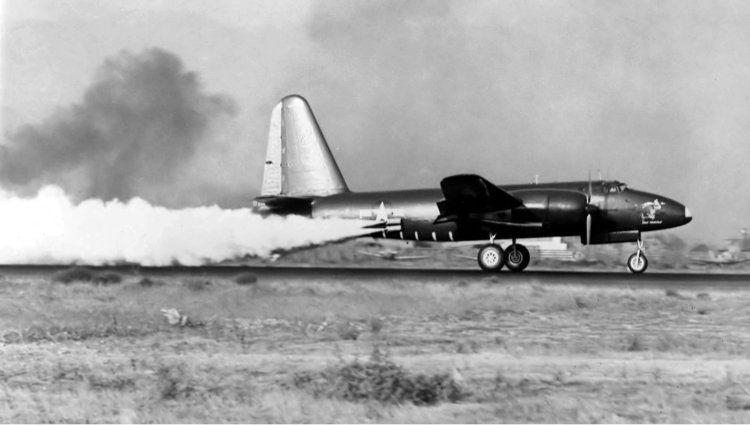 |
|
The Turtle making one of three JATO test flights at Burbank before leaving for Australia. Note the fiducial markings on the fuselage. These markings were removed before the ferry flight to Perth. The aircraft made one more JATO test flight at Perth before departing on the record flight. (Picture: Lockheed)
|
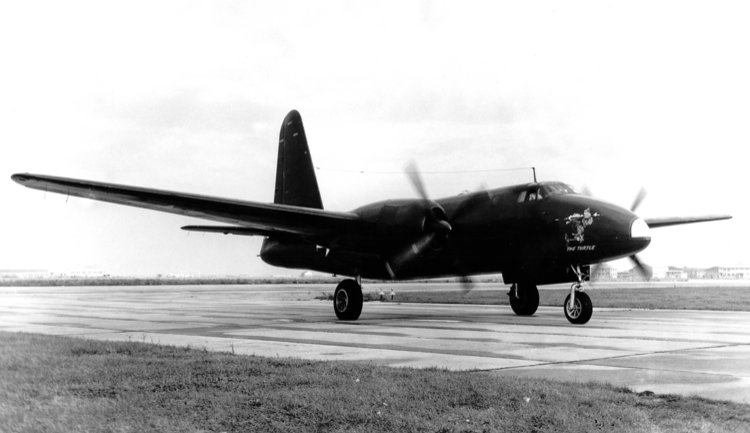 |
|
The
Turtle taxying at an unknown location in the United States.
|
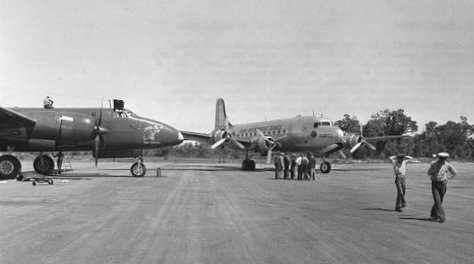 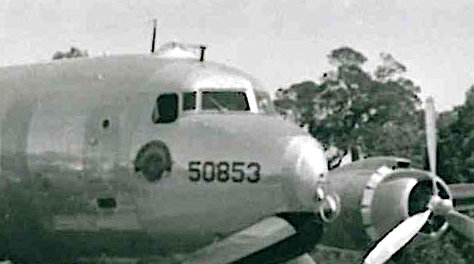 |
|
The
Turtle and its support R5D Skymaster together at Perth.
|
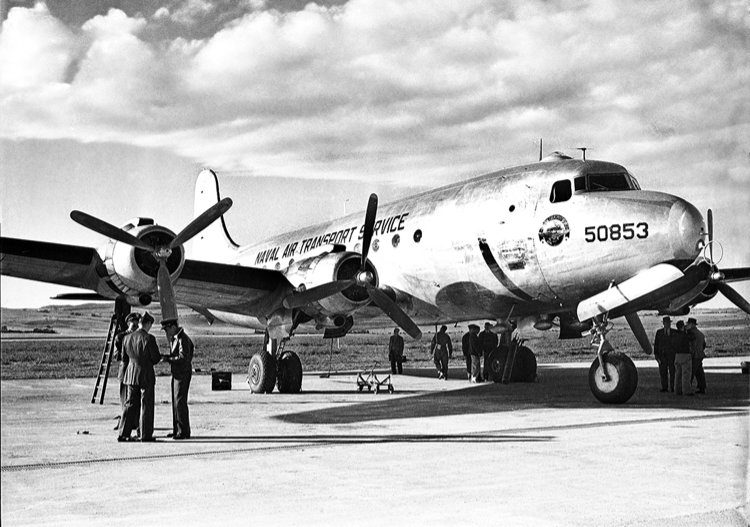 |
|
R5D-2 Skymaster
BuNo 50853 at Parafield on 19 September 1946 preparing to depart for
Perth.
|
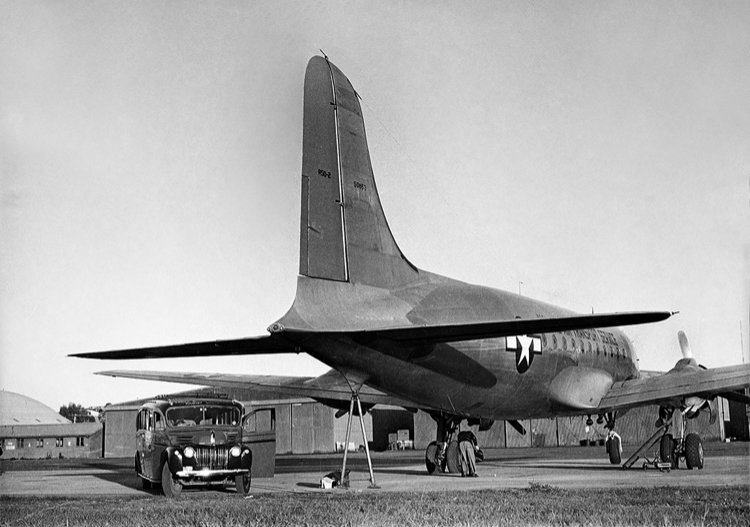 |
|
R5D-2 Skymaster
BuNo 50853 at Parafield on 19 September 1946 preparing to depart for
Perth.
|
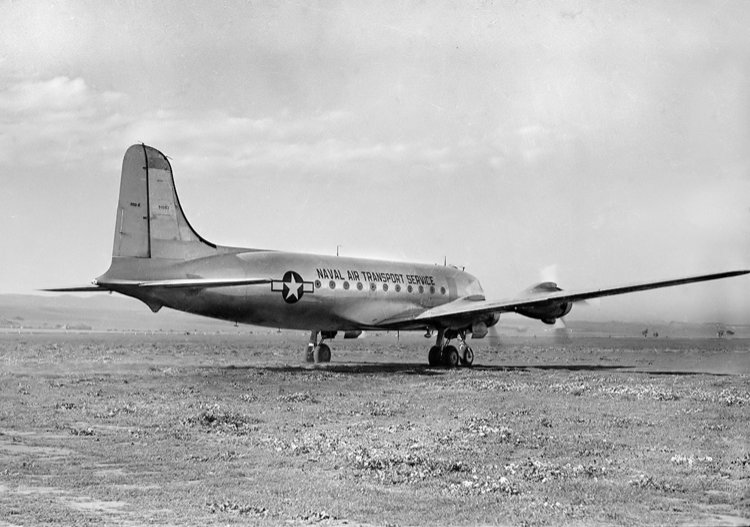 |
|
R5D-2 Skymaster
BuNo 50853 at Parafield on 19 September 1946 departing for Perth.
|
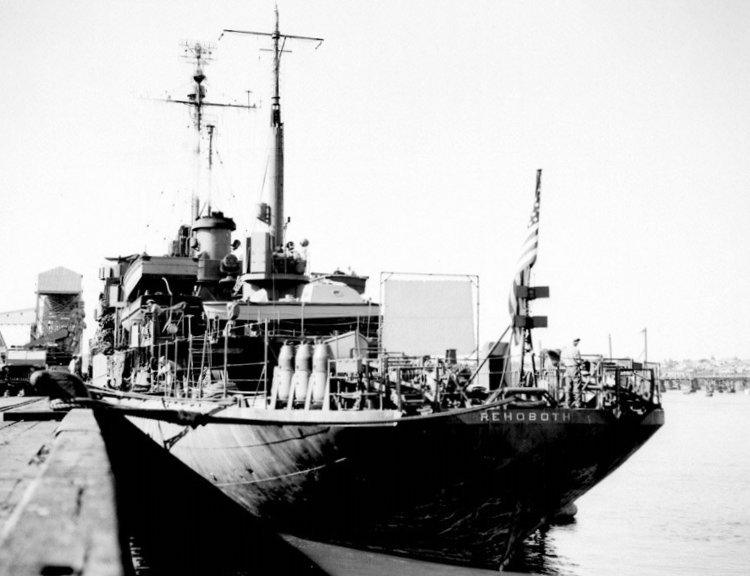 |
|
The
USS Rehoboth berthed in Fremantle, Western Australia in September
1946.
|
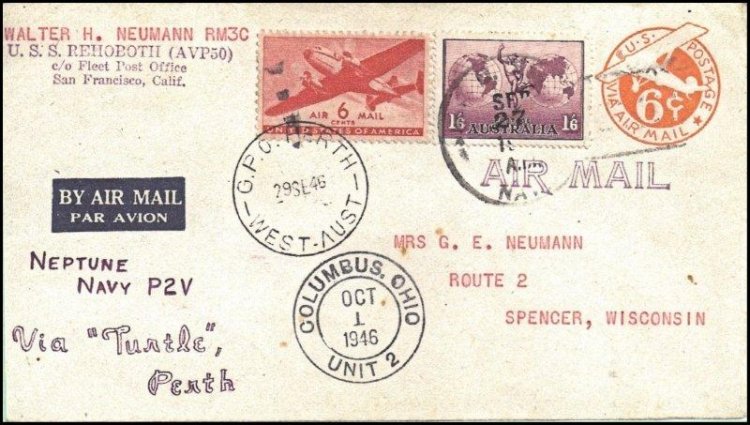 |
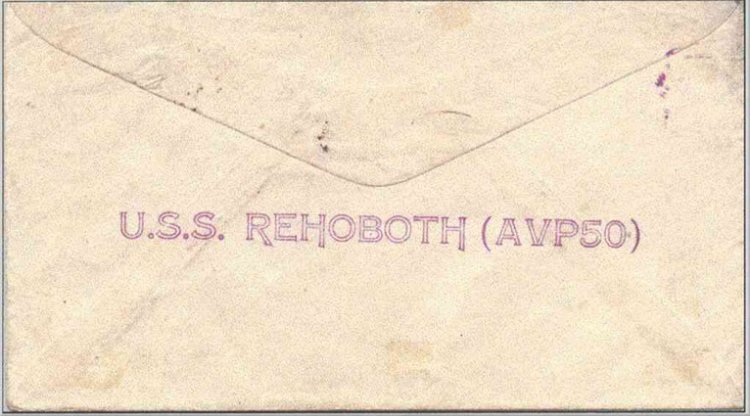 |
|
This flown cover was sent by Radioman Walter H. Neumann who was assigned to the USS Rehoboth when it acted as the support ship for the Turtle. The cover is postmarked Rehoboth on 27 September, Perth on 29 September and Columbus on 1 October. There were approximately 200 of these covers, one of which was given to each person connected with the flight. (Source: 23)
|
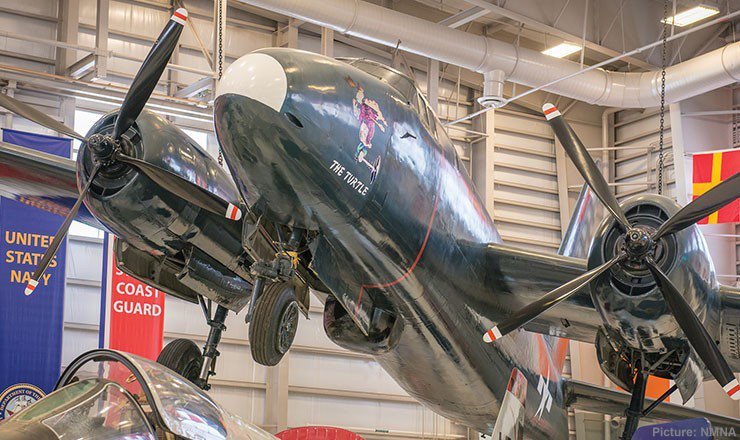 |
|
Lockheed P2V-1 Neptune 89082 The Turtle
(MSN 26-1003) on display at the National Museum of Naval Aviation at
Pensacola, Florida.
|
|
SOURCES
|
|
|
1
|
Francillon, René J, 1987, Lockheed Aircraft since 1913, Putnam. |
|
2
|
Leeke, Jim, 2022, The Turtle and the Dreamboat, Potomac Books. |
|
3
|
Mutza, Wayne, 1996, Lockheed P2V Neptune - an Illustrated History, Schiffer. |
|
4
|
https://www.aerotechnews.com/blog/2022/11/19/on-this-date-138/ |
|
5
|
http://www.navsource.org/archives/09/43/4350.htm |
|
6
|
Advertiser, Adelaide, 19SEP46. |
|
7
|
Advertiser, Adelaide, 20SEP46. |
|
8
|
West Australian, Perth, 19SEP46. |
|
9
|
West Australian, Perth, 20SEP46. |
|
10
|
West Australian, Perth, 21SEP46. |
|
11
|
West Australian, Perth, 23SEP46. |
|
12
|
West Australian, Perth, 24SEP46. |
|
13
|
West Australian, Perth, 25SEP46. |
|
14
|
West Australian, Perth, 27SEP46. |
|
15
|
West Australian, Perth, 30SEP46. |
|
16
|
Daily News , Perth, 27SEP46. |
|
17
|
https://www.key.aero/article/how-lancaster-became-first-british-aircraft-fly-around-world |
|
18
|
Gulliver, Capt Victor S., 2011, The Truculent Turtle's Excellent Adventure, Wings of Gold, Spring 2011 |
|
19
|
https://www.govhouse.qld.gov.au/the-governor-of-queensland/about-the-governor/former-governors-of-queensland |
|
20
|
NAA, Series A9186, Operations Record Book, RAAF Garbutt. |
|
21
|
NAA, Series A9186, Operations Record Book, RAAF Pearce. |
|
22
|
https://www.vpnavy.com/misc_07b/turtlehistory_01_jun77_01oct2004.jpg |
|
23
|
https://www.vpnavy.com/turtle_05.html |
|
24
|
West Australian, Perth, 26SEP46. |
|
Issue
|
Date
|
Remarks |
|
2
|
08JUN23
|
Added three images of the R5D Skymaster at Parafield from the Ron Blum Collection via Nigel Daw. |
|
1
|
02MAY23
|
Original issue. |
|
Australian Neptunes |
|
Return to the Lockheed File |